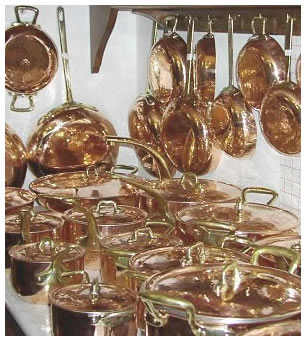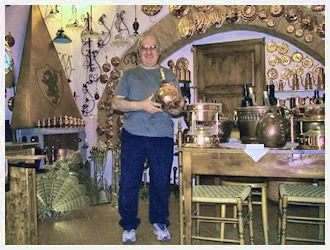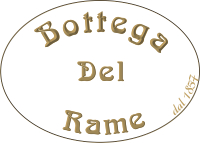Our Italian cuisine
Copper has extraordinary properties, insomuch as it was the first metal to be actually used since prehistoric times.
It was used with other tools made of bone, wood or polished stone.
But, at least in this section, we are not going to dwell on it. For a more complete examination of the subject, refer to the pages on the history of copper.
Thanks to its extraordinary properties we mentioned above, some people Many of these extraordinary qualities are closely linked to the high conductivity of the metal.
Electrical and thermal conductivity. Copper ability to transmit heat is very high (it is second only to silver, and much higher in the rank, to the diamond) and uniform, and this is the reason why copper is the best metal to cook in.
The homogeneous distribution of the heat allows cooking food gently, preserving its nutritional and organoleptic characteristics.
In addition, the food doesn't stick to the bottom of the cookware.
Obviously, in order to get the best results the fact that a pan or a pot is made of copper is not enough.
The thickness of the foil is critical too.
In fact, the cooking quality also depends on the "thermal flywheel" effect generated by the foil thickness.
It is not unusual to find on the market very light copper cookware pieces that don't certainly perform as well as ours. 
Another fundamental element is the shape. forma della pentola.
Italy is world famous for the typicality of its many regional cuisines. And as much typical and regional are the shapes of the traditional pots result of hundreds-year-old experience and tiny improving.
These pieces of cookware are as different as the many regional recipes they serve to cook.
At the beginning of the 20th century aluminium cookware replaced copper in many families, it was lighter, cheaper and "more futuristic".
Stainless steel cookware appeared about 40 years ago. More recently it has been flanked by alloy pots.
All these attempts of "modernizing" cookware, in the desperate search for the best dietary result have produced quite the opposite: an aggressive way of cooking.
Steel, for example, having a very low heat transfer index, exposes the part of food which is over the bottom to a higher temperature compared to the upper part.
In addition, the parts which are touched by the flame become hotter than the others and tend to stick to the pot/pan.
You may say that these problems can be solved by simply stirring the food, the truth is that the remarkable temperature variation influences negatively the final result.
Thermal conductivity *
Copper |
Aluminium |
Steel |
392 W/m°C |
225 W/m°C |
16 W/m°C |
Copper heat surrounds and caresses food. Cooking is faster, leaving aromas and flavours intact.
In the light of present knowledge we can safely say that the most modern material for cookware is copper, used for over five hundred years. It is no coincidence that the best chefs only use copper pots.
Cooking with copper is easy, even easier than cooking with other materials. You only need to follow two simple rules: 
- use wooden tools only, in order not to damage the tinning;
- cook at very low temperature (as it was said before, copper features very high heat conductivity).
Copper cookware can be easily washed, also because food doesn't stick to the bottom. In addition, they can be directly brought to table as serving plate to make a good impression during a formal dinner: they are so beautiful that it would be a shame not to show them.
Whether an omelette, pork loin, a sea bass or some ragout sauce, it doesn't matter. Cooking with copper is better! It's another world!
First time use advice
Tradition requires some vegetables boiling for several minutes before first use. .
Cleaning
Use common dish soap to wash the inner surface, avoid abrasive products. Should you find any mark produced by some acidic food on the tinned surface, don't worry, your pot is still functional and safe. On the other hand, the outer part tends to get dark. To keep it shiny, it can be polished every now and then with:
-
lemon juice and salt
-
vinegar and salt
-
lemon juice and corn flour
-
bran
-
tomato
-
kiwi (using the inner part of the skin)
-
any copper polishing product.


